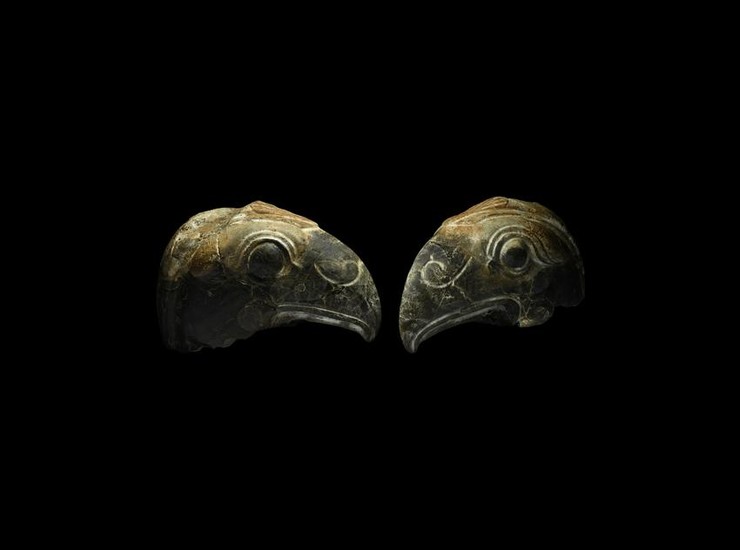Hellenistic Carved Head of a Bird of Prey
Asia Minor, 4th-3rd century BC. An outstanding head of a large bird of prey, expertly carved in the round from a piece of chert, once being part of a monumental finial or larger-than-life size statue of an eagle; the upper part of the beak is decorated by two volutes, a shell-pattern decoration on the forehead of the eagle. See Humann, C., Puchstein, O. Reisen in Kleinasien und Nordsyrien: ausgeführt im Auftrage der Königlichen Preussischen Akademie der Wissenschaften (Atlas), Berlin, 1890; Blömer M., Crowther C., ‘Eagles on Stags. Preliminary Notes on a Recently Discovered Underground Sanctuary in Perrhe’ in Winter E. (ed.), Kult und Herrschaft am Euphrat, Dolichener und Kommagenische Forschungen VI, Bonn, 2014, pp.343-372; Versluys, M.J. Visual Style and constructing Identity in the Hellenistic World: Nemrut Dag and Commagene under Antiochos I Cambridge University Press, 2017. Kallos Gallery, 14-16 Davies St, Mayfair, London, catalogue 3, item 15; and Apollo Magazine, February 1978; accompanied by a copy of the Kallos Gallery catalogue. Exhibited: Tefaf Maastricht (10 March 2018 - 18 March 2019), Masterpiece London (28 June 2018 - 4 July 2018), and on loan to the Corning Museum, New York, 1984. 2.6 kg total, 28cm with stand (11"). Property of a London gentleman; formerly with Kallos Gallery, 14-16 Davies St, Mayfair, London, W1; previously with a central London gallery since the early 1980s; accompanied by a letter from Dr. Donald B. Harden dated 10 February 1982, and an academic archaeological report by specialist Dr Raffaele D'Amato. The origin for the item has been proposed in the region of Commagene between the Taurus Mountains and the River Euphrates. The rulers of this area were within the Achaemenid Empire until the 4th century BC when allegiance switched to the Seleucid dynasty and, after 160 BC, the area formed a discreet Hellenistic polity. Antiochus I commissioned fantastic sculptures for his 1st century BC mausoleum at Nemrud Dag which included monumental eagle statues of a Graeco-Persian syncretic style. It is possible that this head is a precursor of these, an earlier form which retains a stronger Persian influence.
Condition Report: Fine condition. Extremely rare.
View it on
Estimate
Time, Location
Auction House
Asia Minor, 4th-3rd century BC. An outstanding head of a large bird of prey, expertly carved in the round from a piece of chert, once being part of a monumental finial or larger-than-life size statue of an eagle; the upper part of the beak is decorated by two volutes, a shell-pattern decoration on the forehead of the eagle. See Humann, C., Puchstein, O. Reisen in Kleinasien und Nordsyrien: ausgeführt im Auftrage der Königlichen Preussischen Akademie der Wissenschaften (Atlas), Berlin, 1890; Blömer M., Crowther C., ‘Eagles on Stags. Preliminary Notes on a Recently Discovered Underground Sanctuary in Perrhe’ in Winter E. (ed.), Kult und Herrschaft am Euphrat, Dolichener und Kommagenische Forschungen VI, Bonn, 2014, pp.343-372; Versluys, M.J. Visual Style and constructing Identity in the Hellenistic World: Nemrut Dag and Commagene under Antiochos I Cambridge University Press, 2017. Kallos Gallery, 14-16 Davies St, Mayfair, London, catalogue 3, item 15; and Apollo Magazine, February 1978; accompanied by a copy of the Kallos Gallery catalogue. Exhibited: Tefaf Maastricht (10 March 2018 - 18 March 2019), Masterpiece London (28 June 2018 - 4 July 2018), and on loan to the Corning Museum, New York, 1984. 2.6 kg total, 28cm with stand (11"). Property of a London gentleman; formerly with Kallos Gallery, 14-16 Davies St, Mayfair, London, W1; previously with a central London gallery since the early 1980s; accompanied by a letter from Dr. Donald B. Harden dated 10 February 1982, and an academic archaeological report by specialist Dr Raffaele D'Amato. The origin for the item has been proposed in the region of Commagene between the Taurus Mountains and the River Euphrates. The rulers of this area were within the Achaemenid Empire until the 4th century BC when allegiance switched to the Seleucid dynasty and, after 160 BC, the area formed a discreet Hellenistic polity. Antiochus I commissioned fantastic sculptures for his 1st century BC mausoleum at Nemrud Dag which included monumental eagle statues of a Graeco-Persian syncretic style. It is possible that this head is a precursor of these, an earlier form which retains a stronger Persian influence.
Condition Report: Fine condition. Extremely rare.



